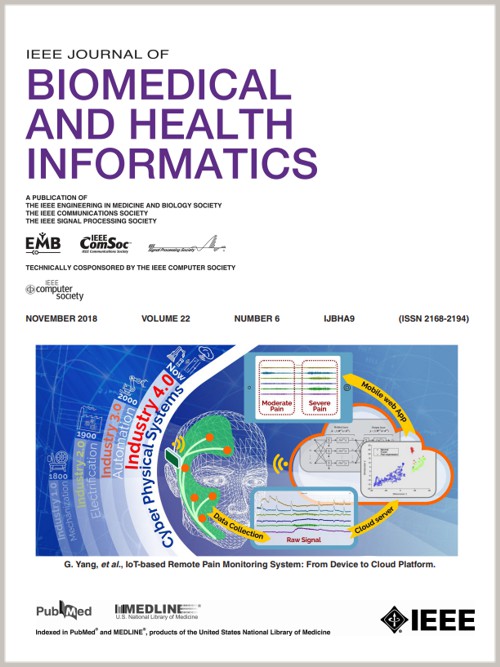从单幅图像中提取多级噪声样本,用于低剂量断层扫描重建
IF 6.7
2区 医学
Q1 COMPUTER SCIENCE, INFORMATION SYSTEMS
IEEE Journal of Biomedical and Health Informatics
Pub Date : 2024-11-11
DOI:10.1109/JBHI.2024.3486726
引用次数: 0
摘要
低剂量数字放射摄影(DR)和计算机断层扫描(CT)因辐射剂量减少而越来越受欢迎。然而,它们通常会产生信噪比较低的退化图像,因此迫切需要有效的去噪技术。最近,基于单图像的去噪方法取得了进展,提供了一种不需要成对训练数据的有前途的解决方案,而这种数据在医学成像中非常稀缺。这些方法通常依赖于从噪声图像中抽取图像对进行监督间去噪。这些方法虽然简单,但生成的图像对噪声水平相同,而且只包含输入图像的部分信息。本研究认为,在充分利用输入图像信息的同时生成不同噪声水平的图像对更可取,因为它能提供更丰富的多角度线索来指导去噪过程。为此,我们提出了一种用于低剂量断层扫描去噪的新型多级噪声采样(MNS)方法。具体来说,MNS 方法通过将高维输入空间分割成多个低维子空间,以简单而有效的策略生成多级噪声子图像。我们从理论上研究并验证了 MNS 方法在基于单图像的去噪方面优于其他竞争方法。此外,为了缩小自我监督和监督去噪网络之间的差距,我们引入了一个优化函数,利用多级噪声子图像的先验知识来指导训练过程。通过在大规模临床低剂量 CT 和 DR 数据集上进行广泛的定量和定性实验,我们验证了 MNS 方法的有效性和优越性,超过了其他最先进的监督和自我监督方法。本文章由计算机程序翻译,如有差异,请以英文原文为准。
Multi-Level Noise Sampling From Single Image for Low-Dose Tomography Reconstruction
Low-dose digital radiography (DR) and computed tomography (CT) become increasingly popular due to reduced radiation dose. However, they often result in degraded images with lower signal-to-noise ratios, creating an urgent need for effective denoising techniques. The recent advancement of the single-image-based denoising approach provides a promising solution without requirement of pairwise training data, which are scarce in medical imaging. These methods typically rely on sampling image pairs from a noisy image for inter-supervised denoising. Although enjoying simplicity, the generated image pairs are at the same noise level and only include partial information about the input images. This study argues that generating image pairs at different noise levels while fully using the information of the input image is preferable since it could provide richer multi-perspective clues to guide the denoising process. To this end, we present a novel Multi-Level Noise Sampling (MNS) method for low-dose tomography denoising. Specifically, MNS method generates multi-level noisy sub-images by partitioning the high-dimensional input space into multiple low-dimensional sub-spaces with a simple yet effective strategy. The superiority of the MNS method in single-image-based denoising over the competing methods has been investigated and verified theoretically. Moreover, to bridge the gap between self-supervised and supervised denoising networks, we introduce an optimization function that leverages prior knowledge of multi-level noisy sub-images to guide the training process. Through extensive quantitative and qualitative experiments conducted on large-scale clinical low-dose CT and DR datasets, we validate the effectiveness and superiority of our MNS approach over other state-of-the-art supervised and self-supervised methods.
求助全文
通过发布文献求助,成功后即可免费获取论文全文。
去求助
来源期刊

IEEE Journal of Biomedical and Health Informatics
COMPUTER SCIENCE, INFORMATION SYSTEMS-COMPUTER SCIENCE, INTERDISCIPLINARY APPLICATIONS
CiteScore
13.60
自引率
6.50%
发文量
1151
期刊介绍:
IEEE Journal of Biomedical and Health Informatics publishes original papers presenting recent advances where information and communication technologies intersect with health, healthcare, life sciences, and biomedicine. Topics include acquisition, transmission, storage, retrieval, management, and analysis of biomedical and health information. The journal covers applications of information technologies in healthcare, patient monitoring, preventive care, early disease diagnosis, therapy discovery, and personalized treatment protocols. It explores electronic medical and health records, clinical information systems, decision support systems, medical and biological imaging informatics, wearable systems, body area/sensor networks, and more. Integration-related topics like interoperability, evidence-based medicine, and secure patient data are also addressed.
 求助内容:
求助内容: 应助结果提醒方式:
应助结果提醒方式:


